Literature Review: PUBH6008 on Homesickness of International Students
VerifiedAdded on 2022/09/14
|15
|4616
|9
Report
AI Summary
This report, prepared for PUBH6008: Capstone A, delves into the pervasive issue of homesickness among international students. It begins by outlining the research questions that guide the study, focusing on the mental health challenges, underlying causes, and potential remedies for homesickness. The report details the search strategy employed to gather relevant data from sources like Google Scholar and ResearchGate, ensuring the inclusion of recent and peer-reviewed literature. It provides a comprehensive understanding of the key issues, including language barriers, cultural differences, discrimination, and food habits, which contribute to feelings of isolation, stress, and depression among international students. The report also explores theoretical frameworks, such as the Loss Model, Interruption Model, Reduced Control Model, and Self-consciousness and Role Change Model, to explain the psychological processes involved in homesickness. Furthermore, it examines potential solutions and interventions, while also identifying gaps in the existing body of knowledge, concluding with a call for further research and improved support systems for international students. The report emphasizes the importance of addressing homesickness to promote the mental well-being and academic success of students studying abroad.
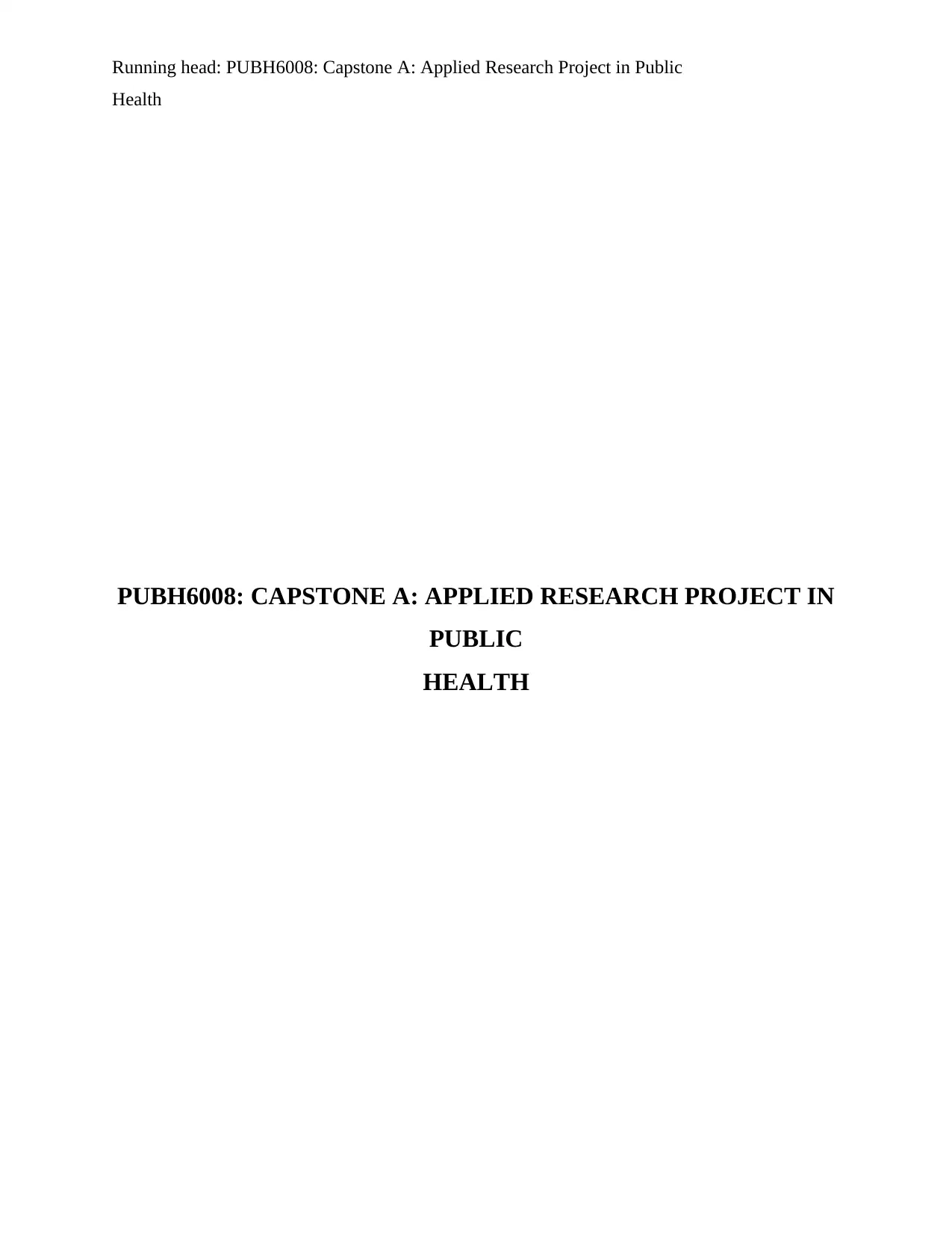
Running head: PUBH6008: Capstone A: Applied Research Project in Public
Health
PUBH6008: CAPSTONE A: APPLIED RESEARCH PROJECT IN
PUBLIC
HEALTH
Health
PUBH6008: CAPSTONE A: APPLIED RESEARCH PROJECT IN
PUBLIC
HEALTH
Paraphrase This Document
Need a fresh take? Get an instant paraphrase of this document with our AI Paraphraser
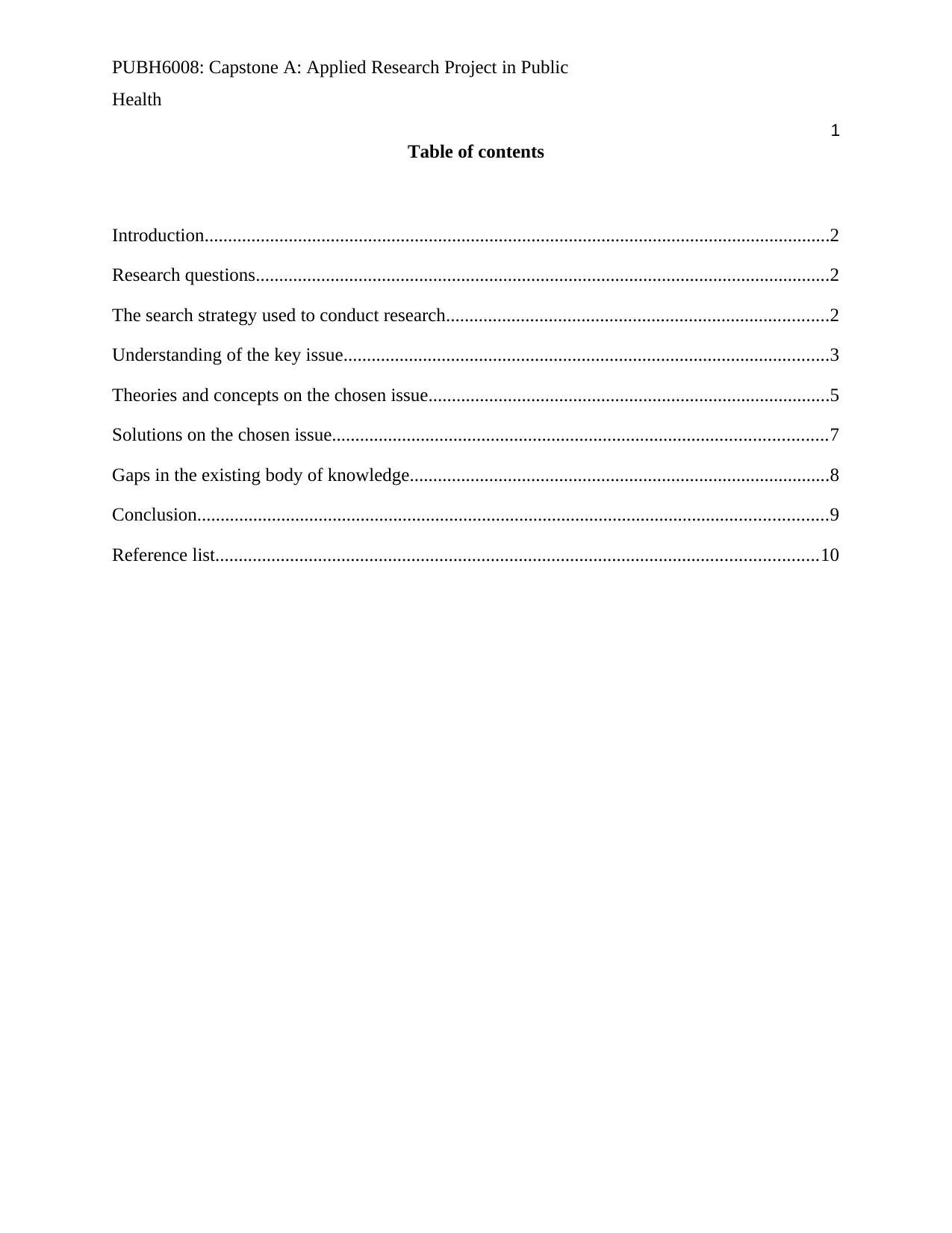
PUBH6008: Capstone A: Applied Research Project in Public
Health
1
Table of contents
Introduction......................................................................................................................................2
Research questions...........................................................................................................................2
The search strategy used to conduct research..................................................................................2
Understanding of the key issue........................................................................................................3
Theories and concepts on the chosen issue......................................................................................5
Solutions on the chosen issue..........................................................................................................7
Gaps in the existing body of knowledge..........................................................................................8
Conclusion.......................................................................................................................................9
Reference list.................................................................................................................................10
Health
1
Table of contents
Introduction......................................................................................................................................2
Research questions...........................................................................................................................2
The search strategy used to conduct research..................................................................................2
Understanding of the key issue........................................................................................................3
Theories and concepts on the chosen issue......................................................................................5
Solutions on the chosen issue..........................................................................................................7
Gaps in the existing body of knowledge..........................................................................................8
Conclusion.......................................................................................................................................9
Reference list.................................................................................................................................10
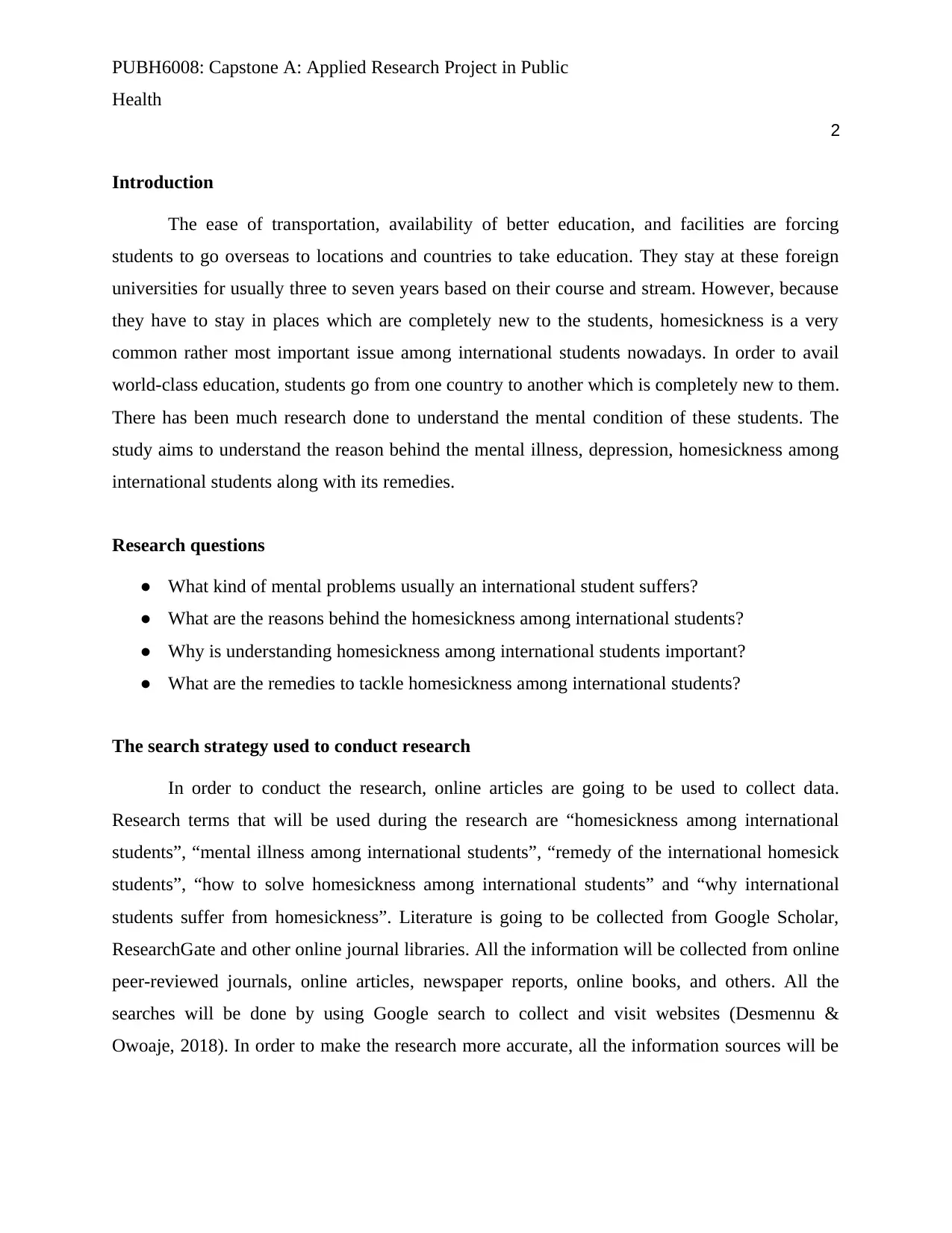
PUBH6008: Capstone A: Applied Research Project in Public
Health
2
Introduction
The ease of transportation, availability of better education, and facilities are forcing
students to go overseas to locations and countries to take education. They stay at these foreign
universities for usually three to seven years based on their course and stream. However, because
they have to stay in places which are completely new to the students, homesickness is a very
common rather most important issue among international students nowadays. In order to avail
world-class education, students go from one country to another which is completely new to them.
There has been much research done to understand the mental condition of these students. The
study aims to understand the reason behind the mental illness, depression, homesickness among
international students along with its remedies.
Research questions
● What kind of mental problems usually an international student suffers?
● What are the reasons behind the homesickness among international students?
● Why is understanding homesickness among international students important?
● What are the remedies to tackle homesickness among international students?
The search strategy used to conduct research
In order to conduct the research, online articles are going to be used to collect data.
Research terms that will be used during the research are “homesickness among international
students”, “mental illness among international students”, “remedy of the international homesick
students”, “how to solve homesickness among international students” and “why international
students suffer from homesickness”. Literature is going to be collected from Google Scholar,
ResearchGate and other online journal libraries. All the information will be collected from online
peer-reviewed journals, online articles, newspaper reports, online books, and others. All the
searches will be done by using Google search to collect and visit websites (Desmennu &
Owoaje, 2018). In order to make the research more accurate, all the information sources will be
Health
2
Introduction
The ease of transportation, availability of better education, and facilities are forcing
students to go overseas to locations and countries to take education. They stay at these foreign
universities for usually three to seven years based on their course and stream. However, because
they have to stay in places which are completely new to the students, homesickness is a very
common rather most important issue among international students nowadays. In order to avail
world-class education, students go from one country to another which is completely new to them.
There has been much research done to understand the mental condition of these students. The
study aims to understand the reason behind the mental illness, depression, homesickness among
international students along with its remedies.
Research questions
● What kind of mental problems usually an international student suffers?
● What are the reasons behind the homesickness among international students?
● Why is understanding homesickness among international students important?
● What are the remedies to tackle homesickness among international students?
The search strategy used to conduct research
In order to conduct the research, online articles are going to be used to collect data.
Research terms that will be used during the research are “homesickness among international
students”, “mental illness among international students”, “remedy of the international homesick
students”, “how to solve homesickness among international students” and “why international
students suffer from homesickness”. Literature is going to be collected from Google Scholar,
ResearchGate and other online journal libraries. All the information will be collected from online
peer-reviewed journals, online articles, newspaper reports, online books, and others. All the
searches will be done by using Google search to collect and visit websites (Desmennu &
Owoaje, 2018). In order to make the research more accurate, all the information sources will be
⊘ This is a preview!⊘
Do you want full access?
Subscribe today to unlock all pages.

Trusted by 1+ million students worldwide
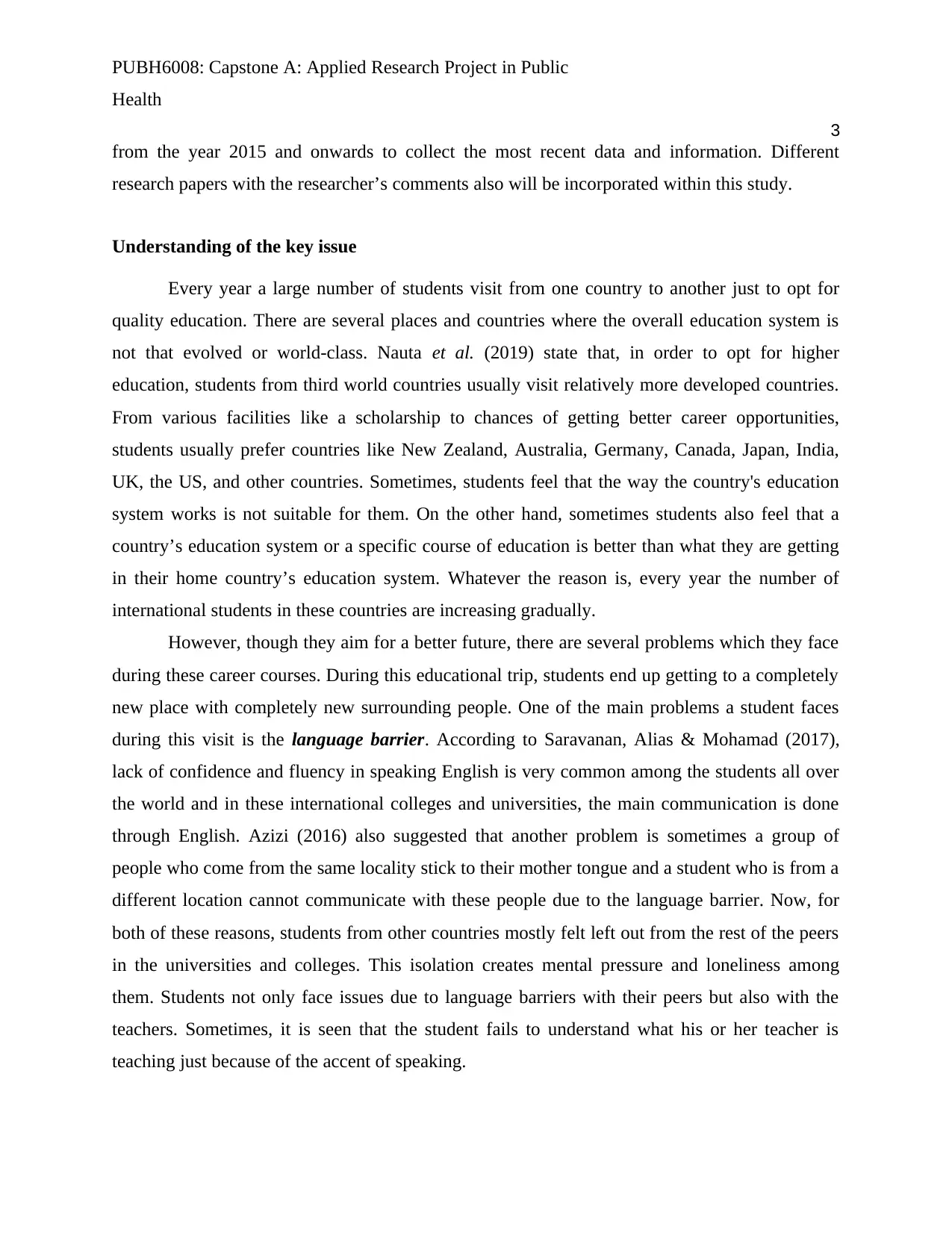
PUBH6008: Capstone A: Applied Research Project in Public
Health
3
from the year 2015 and onwards to collect the most recent data and information. Different
research papers with the researcher’s comments also will be incorporated within this study.
Understanding of the key issue
Every year a large number of students visit from one country to another just to opt for
quality education. There are several places and countries where the overall education system is
not that evolved or world-class. Nauta et al. (2019) state that, in order to opt for higher
education, students from third world countries usually visit relatively more developed countries.
From various facilities like a scholarship to chances of getting better career opportunities,
students usually prefer countries like New Zealand, Australia, Germany, Canada, Japan, India,
UK, the US, and other countries. Sometimes, students feel that the way the country's education
system works is not suitable for them. On the other hand, sometimes students also feel that a
country’s education system or a specific course of education is better than what they are getting
in their home country’s education system. Whatever the reason is, every year the number of
international students in these countries are increasing gradually.
However, though they aim for a better future, there are several problems which they face
during these career courses. During this educational trip, students end up getting to a completely
new place with completely new surrounding people. One of the main problems a student faces
during this visit is the language barrier. According to Saravanan, Alias & Mohamad (2017),
lack of confidence and fluency in speaking English is very common among the students all over
the world and in these international colleges and universities, the main communication is done
through English. Azizi (2016) also suggested that another problem is sometimes a group of
people who come from the same locality stick to their mother tongue and a student who is from a
different location cannot communicate with these people due to the language barrier. Now, for
both of these reasons, students from other countries mostly felt left out from the rest of the peers
in the universities and colleges. This isolation creates mental pressure and loneliness among
them. Students not only face issues due to language barriers with their peers but also with the
teachers. Sometimes, it is seen that the student fails to understand what his or her teacher is
teaching just because of the accent of speaking.
Health
3
from the year 2015 and onwards to collect the most recent data and information. Different
research papers with the researcher’s comments also will be incorporated within this study.
Understanding of the key issue
Every year a large number of students visit from one country to another just to opt for
quality education. There are several places and countries where the overall education system is
not that evolved or world-class. Nauta et al. (2019) state that, in order to opt for higher
education, students from third world countries usually visit relatively more developed countries.
From various facilities like a scholarship to chances of getting better career opportunities,
students usually prefer countries like New Zealand, Australia, Germany, Canada, Japan, India,
UK, the US, and other countries. Sometimes, students feel that the way the country's education
system works is not suitable for them. On the other hand, sometimes students also feel that a
country’s education system or a specific course of education is better than what they are getting
in their home country’s education system. Whatever the reason is, every year the number of
international students in these countries are increasing gradually.
However, though they aim for a better future, there are several problems which they face
during these career courses. During this educational trip, students end up getting to a completely
new place with completely new surrounding people. One of the main problems a student faces
during this visit is the language barrier. According to Saravanan, Alias & Mohamad (2017),
lack of confidence and fluency in speaking English is very common among the students all over
the world and in these international colleges and universities, the main communication is done
through English. Azizi (2016) also suggested that another problem is sometimes a group of
people who come from the same locality stick to their mother tongue and a student who is from a
different location cannot communicate with these people due to the language barrier. Now, for
both of these reasons, students from other countries mostly felt left out from the rest of the peers
in the universities and colleges. This isolation creates mental pressure and loneliness among
them. Students not only face issues due to language barriers with their peers but also with the
teachers. Sometimes, it is seen that the student fails to understand what his or her teacher is
teaching just because of the accent of speaking.
Paraphrase This Document
Need a fresh take? Get an instant paraphrase of this document with our AI Paraphraser
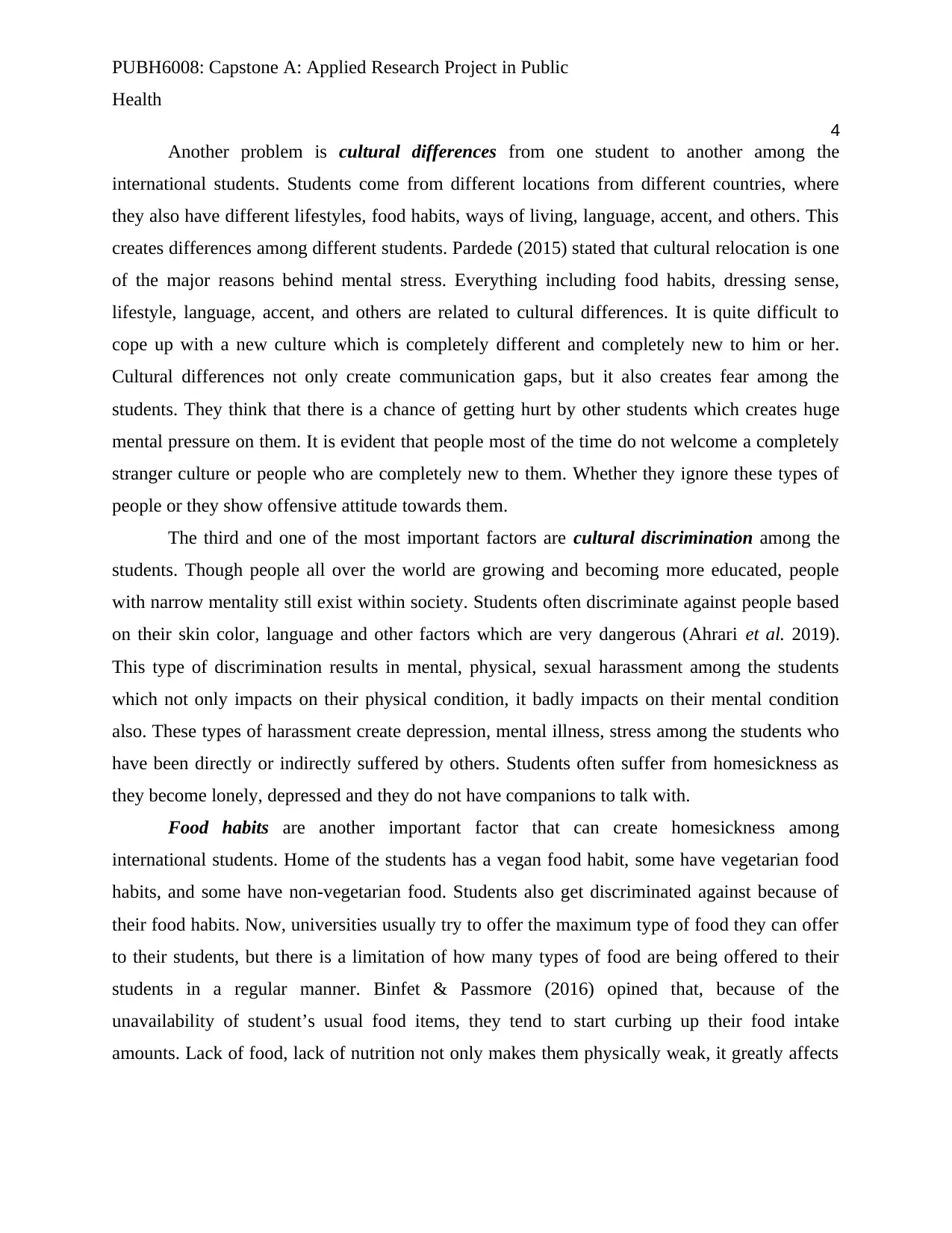
PUBH6008: Capstone A: Applied Research Project in Public
Health
4
Another problem is cultural differences from one student to another among the
international students. Students come from different locations from different countries, where
they also have different lifestyles, food habits, ways of living, language, accent, and others. This
creates differences among different students. Pardede (2015) stated that cultural relocation is one
of the major reasons behind mental stress. Everything including food habits, dressing sense,
lifestyle, language, accent, and others are related to cultural differences. It is quite difficult to
cope up with a new culture which is completely different and completely new to him or her.
Cultural differences not only create communication gaps, but it also creates fear among the
students. They think that there is a chance of getting hurt by other students which creates huge
mental pressure on them. It is evident that people most of the time do not welcome a completely
stranger culture or people who are completely new to them. Whether they ignore these types of
people or they show offensive attitude towards them.
The third and one of the most important factors are cultural discrimination among the
students. Though people all over the world are growing and becoming more educated, people
with narrow mentality still exist within society. Students often discriminate against people based
on their skin color, language and other factors which are very dangerous (Ahrari et al. 2019).
This type of discrimination results in mental, physical, sexual harassment among the students
which not only impacts on their physical condition, it badly impacts on their mental condition
also. These types of harassment create depression, mental illness, stress among the students who
have been directly or indirectly suffered by others. Students often suffer from homesickness as
they become lonely, depressed and they do not have companions to talk with.
Food habits are another important factor that can create homesickness among
international students. Home of the students has a vegan food habit, some have vegetarian food
habits, and some have non-vegetarian food. Students also get discriminated against because of
their food habits. Now, universities usually try to offer the maximum type of food they can offer
to their students, but there is a limitation of how many types of food are being offered to their
students in a regular manner. Binfet & Passmore (2016) opined that, because of the
unavailability of student’s usual food items, they tend to start curbing up their food intake
amounts. Lack of food, lack of nutrition not only makes them physically weak, it greatly affects
Health
4
Another problem is cultural differences from one student to another among the
international students. Students come from different locations from different countries, where
they also have different lifestyles, food habits, ways of living, language, accent, and others. This
creates differences among different students. Pardede (2015) stated that cultural relocation is one
of the major reasons behind mental stress. Everything including food habits, dressing sense,
lifestyle, language, accent, and others are related to cultural differences. It is quite difficult to
cope up with a new culture which is completely different and completely new to him or her.
Cultural differences not only create communication gaps, but it also creates fear among the
students. They think that there is a chance of getting hurt by other students which creates huge
mental pressure on them. It is evident that people most of the time do not welcome a completely
stranger culture or people who are completely new to them. Whether they ignore these types of
people or they show offensive attitude towards them.
The third and one of the most important factors are cultural discrimination among the
students. Though people all over the world are growing and becoming more educated, people
with narrow mentality still exist within society. Students often discriminate against people based
on their skin color, language and other factors which are very dangerous (Ahrari et al. 2019).
This type of discrimination results in mental, physical, sexual harassment among the students
which not only impacts on their physical condition, it badly impacts on their mental condition
also. These types of harassment create depression, mental illness, stress among the students who
have been directly or indirectly suffered by others. Students often suffer from homesickness as
they become lonely, depressed and they do not have companions to talk with.
Food habits are another important factor that can create homesickness among
international students. Home of the students has a vegan food habit, some have vegetarian food
habits, and some have non-vegetarian food. Students also get discriminated against because of
their food habits. Now, universities usually try to offer the maximum type of food they can offer
to their students, but there is a limitation of how many types of food are being offered to their
students in a regular manner. Binfet & Passmore (2016) opined that, because of the
unavailability of student’s usual food items, they tend to start curbing up their food intake
amounts. Lack of food, lack of nutrition not only makes them physically weak, it greatly affects
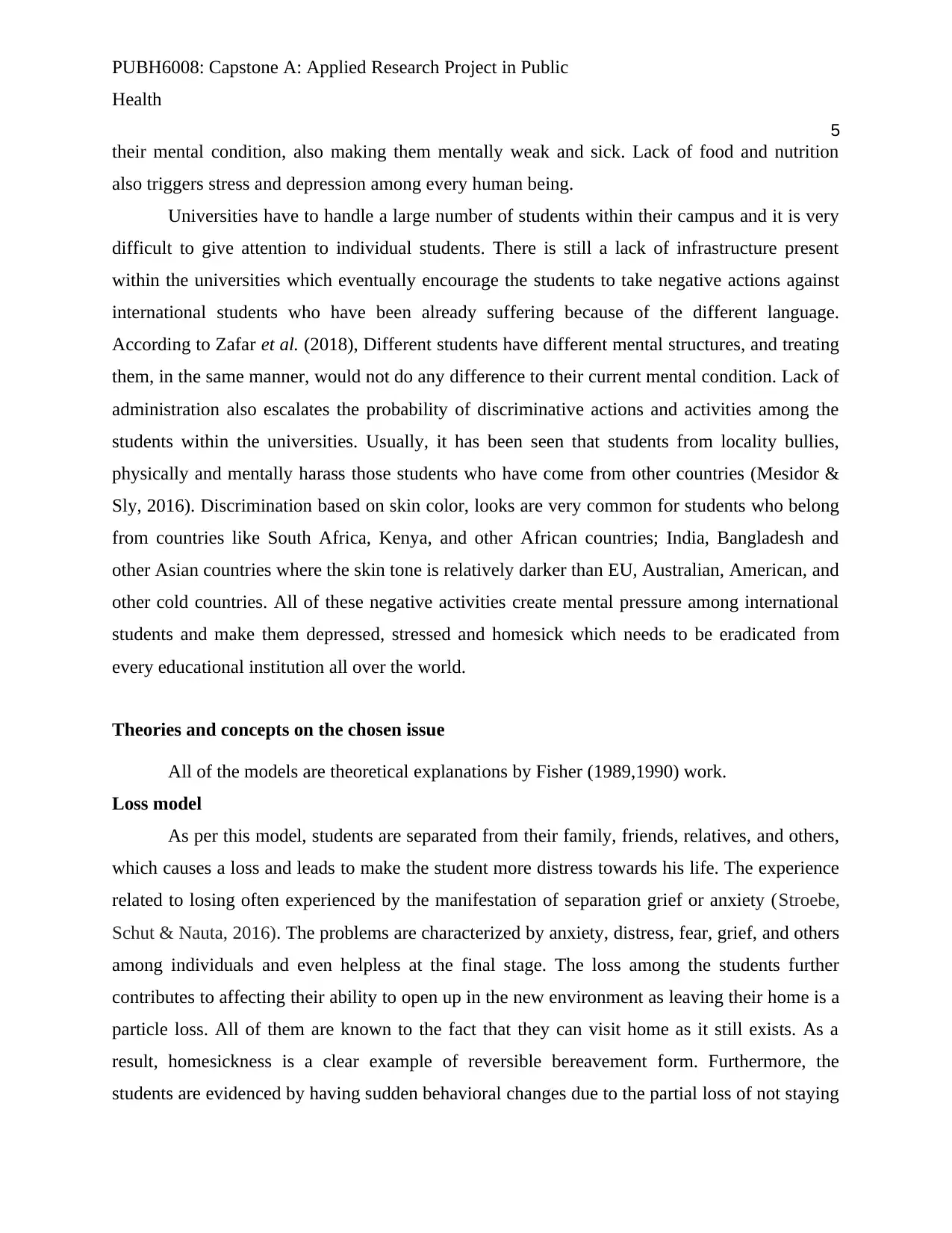
PUBH6008: Capstone A: Applied Research Project in Public
Health
5
their mental condition, also making them mentally weak and sick. Lack of food and nutrition
also triggers stress and depression among every human being.
Universities have to handle a large number of students within their campus and it is very
difficult to give attention to individual students. There is still a lack of infrastructure present
within the universities which eventually encourage the students to take negative actions against
international students who have been already suffering because of the different language.
According to Zafar et al. (2018), Different students have different mental structures, and treating
them, in the same manner, would not do any difference to their current mental condition. Lack of
administration also escalates the probability of discriminative actions and activities among the
students within the universities. Usually, it has been seen that students from locality bullies,
physically and mentally harass those students who have come from other countries (Mesidor &
Sly, 2016). Discrimination based on skin color, looks are very common for students who belong
from countries like South Africa, Kenya, and other African countries; India, Bangladesh and
other Asian countries where the skin tone is relatively darker than EU, Australian, American, and
other cold countries. All of these negative activities create mental pressure among international
students and make them depressed, stressed and homesick which needs to be eradicated from
every educational institution all over the world.
Theories and concepts on the chosen issue
All of the models are theoretical explanations by Fisher (1989,1990) work.
Loss model
As per this model, students are separated from their family, friends, relatives, and others,
which causes a loss and leads to make the student more distress towards his life. The experience
related to losing often experienced by the manifestation of separation grief or anxiety (Stroebe,
Schut & Nauta, 2016). The problems are characterized by anxiety, distress, fear, grief, and others
among individuals and even helpless at the final stage. The loss among the students further
contributes to affecting their ability to open up in the new environment as leaving their home is a
particle loss. All of them are known to the fact that they can visit home as it still exists. As a
result, homesickness is a clear example of reversible bereavement form. Furthermore, the
students are evidenced by having sudden behavioral changes due to the partial loss of not staying
Health
5
their mental condition, also making them mentally weak and sick. Lack of food and nutrition
also triggers stress and depression among every human being.
Universities have to handle a large number of students within their campus and it is very
difficult to give attention to individual students. There is still a lack of infrastructure present
within the universities which eventually encourage the students to take negative actions against
international students who have been already suffering because of the different language.
According to Zafar et al. (2018), Different students have different mental structures, and treating
them, in the same manner, would not do any difference to their current mental condition. Lack of
administration also escalates the probability of discriminative actions and activities among the
students within the universities. Usually, it has been seen that students from locality bullies,
physically and mentally harass those students who have come from other countries (Mesidor &
Sly, 2016). Discrimination based on skin color, looks are very common for students who belong
from countries like South Africa, Kenya, and other African countries; India, Bangladesh and
other Asian countries where the skin tone is relatively darker than EU, Australian, American, and
other cold countries. All of these negative activities create mental pressure among international
students and make them depressed, stressed and homesick which needs to be eradicated from
every educational institution all over the world.
Theories and concepts on the chosen issue
All of the models are theoretical explanations by Fisher (1989,1990) work.
Loss model
As per this model, students are separated from their family, friends, relatives, and others,
which causes a loss and leads to make the student more distress towards his life. The experience
related to losing often experienced by the manifestation of separation grief or anxiety (Stroebe,
Schut & Nauta, 2016). The problems are characterized by anxiety, distress, fear, grief, and others
among individuals and even helpless at the final stage. The loss among the students further
contributes to affecting their ability to open up in the new environment as leaving their home is a
particle loss. All of them are known to the fact that they can visit home as it still exists. As a
result, homesickness is a clear example of reversible bereavement form. Furthermore, the
students are evidenced by having sudden behavioral changes due to the partial loss of not staying
⊘ This is a preview!⊘
Do you want full access?
Subscribe today to unlock all pages.

Trusted by 1+ million students worldwide
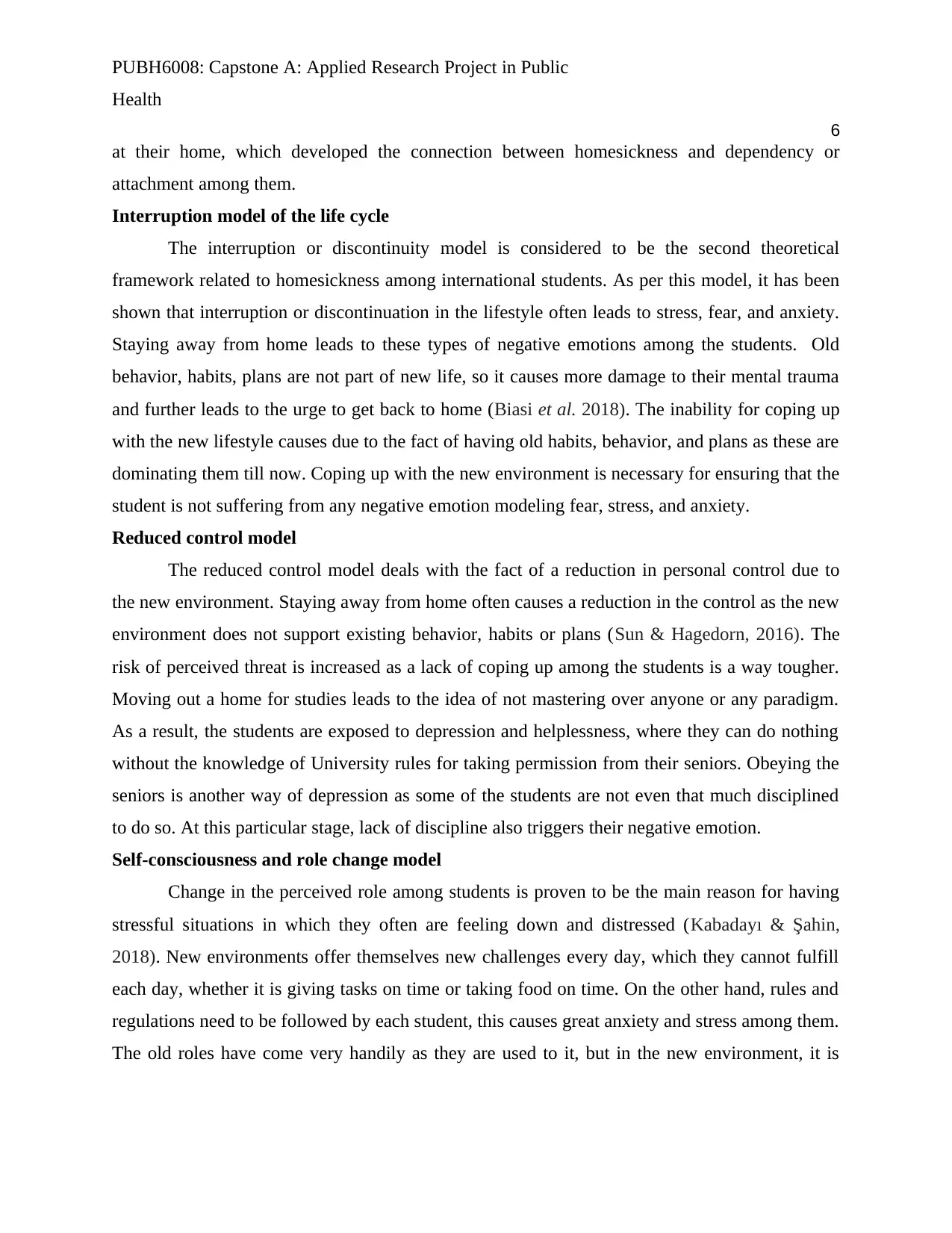
PUBH6008: Capstone A: Applied Research Project in Public
Health
6
at their home, which developed the connection between homesickness and dependency or
attachment among them.
Interruption model of the life cycle
The interruption or discontinuity model is considered to be the second theoretical
framework related to homesickness among international students. As per this model, it has been
shown that interruption or discontinuation in the lifestyle often leads to stress, fear, and anxiety.
Staying away from home leads to these types of negative emotions among the students. Old
behavior, habits, plans are not part of new life, so it causes more damage to their mental trauma
and further leads to the urge to get back to home (Biasi et al. 2018). The inability for coping up
with the new lifestyle causes due to the fact of having old habits, behavior, and plans as these are
dominating them till now. Coping up with the new environment is necessary for ensuring that the
student is not suffering from any negative emotion modeling fear, stress, and anxiety.
Reduced control model
The reduced control model deals with the fact of a reduction in personal control due to
the new environment. Staying away from home often causes a reduction in the control as the new
environment does not support existing behavior, habits or plans (Sun & Hagedorn, 2016). The
risk of perceived threat is increased as a lack of coping up among the students is a way tougher.
Moving out a home for studies leads to the idea of not mastering over anyone or any paradigm.
As a result, the students are exposed to depression and helplessness, where they can do nothing
without the knowledge of University rules for taking permission from their seniors. Obeying the
seniors is another way of depression as some of the students are not even that much disciplined
to do so. At this particular stage, lack of discipline also triggers their negative emotion.
Self-consciousness and role change model
Change in the perceived role among students is proven to be the main reason for having
stressful situations in which they often are feeling down and distressed (Kabadayı & Şahin,
2018). New environments offer themselves new challenges every day, which they cannot fulfill
each day, whether it is giving tasks on time or taking food on time. On the other hand, rules and
regulations need to be followed by each student, this causes great anxiety and stress among them.
The old roles have come very handily as they are used to it, but in the new environment, it is
Health
6
at their home, which developed the connection between homesickness and dependency or
attachment among them.
Interruption model of the life cycle
The interruption or discontinuity model is considered to be the second theoretical
framework related to homesickness among international students. As per this model, it has been
shown that interruption or discontinuation in the lifestyle often leads to stress, fear, and anxiety.
Staying away from home leads to these types of negative emotions among the students. Old
behavior, habits, plans are not part of new life, so it causes more damage to their mental trauma
and further leads to the urge to get back to home (Biasi et al. 2018). The inability for coping up
with the new lifestyle causes due to the fact of having old habits, behavior, and plans as these are
dominating them till now. Coping up with the new environment is necessary for ensuring that the
student is not suffering from any negative emotion modeling fear, stress, and anxiety.
Reduced control model
The reduced control model deals with the fact of a reduction in personal control due to
the new environment. Staying away from home often causes a reduction in the control as the new
environment does not support existing behavior, habits or plans (Sun & Hagedorn, 2016). The
risk of perceived threat is increased as a lack of coping up among the students is a way tougher.
Moving out a home for studies leads to the idea of not mastering over anyone or any paradigm.
As a result, the students are exposed to depression and helplessness, where they can do nothing
without the knowledge of University rules for taking permission from their seniors. Obeying the
seniors is another way of depression as some of the students are not even that much disciplined
to do so. At this particular stage, lack of discipline also triggers their negative emotion.
Self-consciousness and role change model
Change in the perceived role among students is proven to be the main reason for having
stressful situations in which they often are feeling down and distressed (Kabadayı & Şahin,
2018). New environments offer themselves new challenges every day, which they cannot fulfill
each day, whether it is giving tasks on time or taking food on time. On the other hand, rules and
regulations need to be followed by each student, this causes great anxiety and stress among them.
The old roles have come very handily as they are used to it, but in the new environment, it is
Paraphrase This Document
Need a fresh take? Get an instant paraphrase of this document with our AI Paraphraser
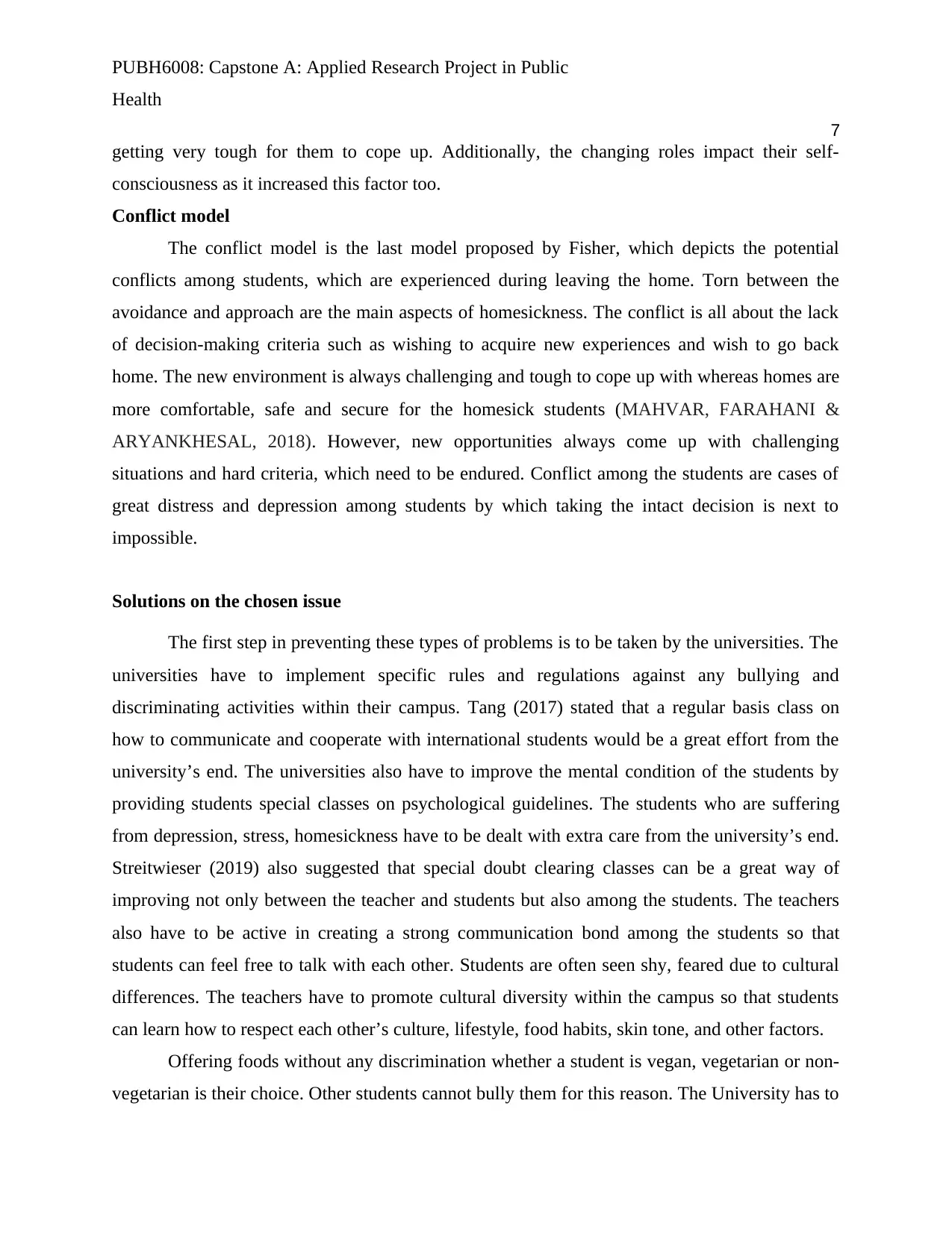
PUBH6008: Capstone A: Applied Research Project in Public
Health
7
getting very tough for them to cope up. Additionally, the changing roles impact their self-
consciousness as it increased this factor too.
Conflict model
The conflict model is the last model proposed by Fisher, which depicts the potential
conflicts among students, which are experienced during leaving the home. Torn between the
avoidance and approach are the main aspects of homesickness. The conflict is all about the lack
of decision-making criteria such as wishing to acquire new experiences and wish to go back
home. The new environment is always challenging and tough to cope up with whereas homes are
more comfortable, safe and secure for the homesick students (MAHVAR, FARAHANI &
ARYANKHESAL, 2018). However, new opportunities always come up with challenging
situations and hard criteria, which need to be endured. Conflict among the students are cases of
great distress and depression among students by which taking the intact decision is next to
impossible.
Solutions on the chosen issue
The first step in preventing these types of problems is to be taken by the universities. The
universities have to implement specific rules and regulations against any bullying and
discriminating activities within their campus. Tang (2017) stated that a regular basis class on
how to communicate and cooperate with international students would be a great effort from the
university’s end. The universities also have to improve the mental condition of the students by
providing students special classes on psychological guidelines. The students who are suffering
from depression, stress, homesickness have to be dealt with extra care from the university’s end.
Streitwieser (2019) also suggested that special doubt clearing classes can be a great way of
improving not only between the teacher and students but also among the students. The teachers
also have to be active in creating a strong communication bond among the students so that
students can feel free to talk with each other. Students are often seen shy, feared due to cultural
differences. The teachers have to promote cultural diversity within the campus so that students
can learn how to respect each other’s culture, lifestyle, food habits, skin tone, and other factors.
Offering foods without any discrimination whether a student is vegan, vegetarian or non-
vegetarian is their choice. Other students cannot bully them for this reason. The University has to
Health
7
getting very tough for them to cope up. Additionally, the changing roles impact their self-
consciousness as it increased this factor too.
Conflict model
The conflict model is the last model proposed by Fisher, which depicts the potential
conflicts among students, which are experienced during leaving the home. Torn between the
avoidance and approach are the main aspects of homesickness. The conflict is all about the lack
of decision-making criteria such as wishing to acquire new experiences and wish to go back
home. The new environment is always challenging and tough to cope up with whereas homes are
more comfortable, safe and secure for the homesick students (MAHVAR, FARAHANI &
ARYANKHESAL, 2018). However, new opportunities always come up with challenging
situations and hard criteria, which need to be endured. Conflict among the students are cases of
great distress and depression among students by which taking the intact decision is next to
impossible.
Solutions on the chosen issue
The first step in preventing these types of problems is to be taken by the universities. The
universities have to implement specific rules and regulations against any bullying and
discriminating activities within their campus. Tang (2017) stated that a regular basis class on
how to communicate and cooperate with international students would be a great effort from the
university’s end. The universities also have to improve the mental condition of the students by
providing students special classes on psychological guidelines. The students who are suffering
from depression, stress, homesickness have to be dealt with extra care from the university’s end.
Streitwieser (2019) also suggested that special doubt clearing classes can be a great way of
improving not only between the teacher and students but also among the students. The teachers
also have to be active in creating a strong communication bond among the students so that
students can feel free to talk with each other. Students are often seen shy, feared due to cultural
differences. The teachers have to promote cultural diversity within the campus so that students
can learn how to respect each other’s culture, lifestyle, food habits, skin tone, and other factors.
Offering foods without any discrimination whether a student is vegan, vegetarian or non-
vegetarian is their choice. Other students cannot bully them for this reason. The University has to
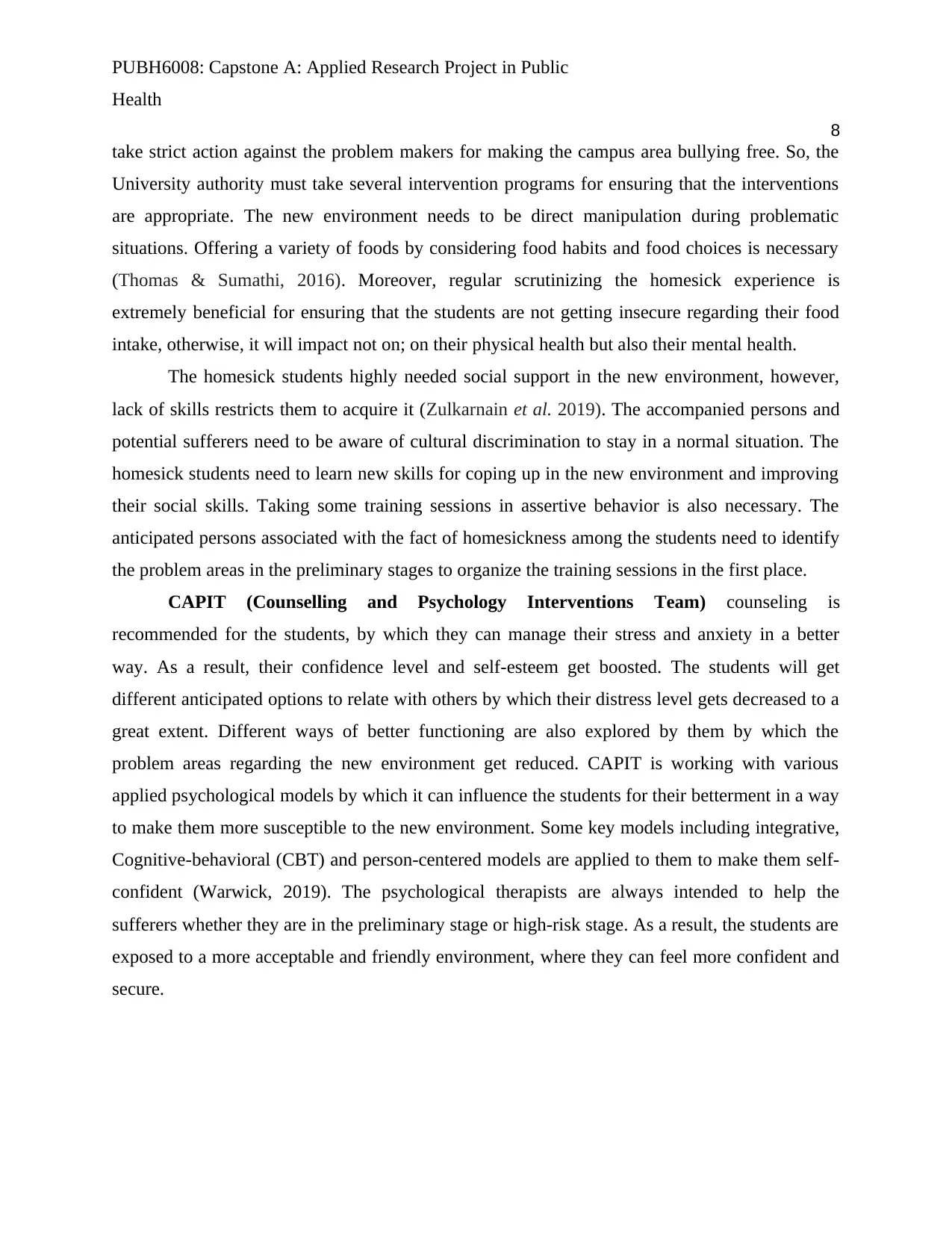
PUBH6008: Capstone A: Applied Research Project in Public
Health
8
take strict action against the problem makers for making the campus area bullying free. So, the
University authority must take several intervention programs for ensuring that the interventions
are appropriate. The new environment needs to be direct manipulation during problematic
situations. Offering a variety of foods by considering food habits and food choices is necessary
(Thomas & Sumathi, 2016). Moreover, regular scrutinizing the homesick experience is
extremely beneficial for ensuring that the students are not getting insecure regarding their food
intake, otherwise, it will impact not on; on their physical health but also their mental health.
The homesick students highly needed social support in the new environment, however,
lack of skills restricts them to acquire it (Zulkarnain et al. 2019). The accompanied persons and
potential sufferers need to be aware of cultural discrimination to stay in a normal situation. The
homesick students need to learn new skills for coping up in the new environment and improving
their social skills. Taking some training sessions in assertive behavior is also necessary. The
anticipated persons associated with the fact of homesickness among the students need to identify
the problem areas in the preliminary stages to organize the training sessions in the first place.
CAPIT (Counselling and Psychology Interventions Team) counseling is
recommended for the students, by which they can manage their stress and anxiety in a better
way. As a result, their confidence level and self-esteem get boosted. The students will get
different anticipated options to relate with others by which their distress level gets decreased to a
great extent. Different ways of better functioning are also explored by them by which the
problem areas regarding the new environment get reduced. CAPIT is working with various
applied psychological models by which it can influence the students for their betterment in a way
to make them more susceptible to the new environment. Some key models including integrative,
Cognitive-behavioral (CBT) and person-centered models are applied to them to make them self-
confident (Warwick, 2019). The psychological therapists are always intended to help the
sufferers whether they are in the preliminary stage or high-risk stage. As a result, the students are
exposed to a more acceptable and friendly environment, where they can feel more confident and
secure.
Health
8
take strict action against the problem makers for making the campus area bullying free. So, the
University authority must take several intervention programs for ensuring that the interventions
are appropriate. The new environment needs to be direct manipulation during problematic
situations. Offering a variety of foods by considering food habits and food choices is necessary
(Thomas & Sumathi, 2016). Moreover, regular scrutinizing the homesick experience is
extremely beneficial for ensuring that the students are not getting insecure regarding their food
intake, otherwise, it will impact not on; on their physical health but also their mental health.
The homesick students highly needed social support in the new environment, however,
lack of skills restricts them to acquire it (Zulkarnain et al. 2019). The accompanied persons and
potential sufferers need to be aware of cultural discrimination to stay in a normal situation. The
homesick students need to learn new skills for coping up in the new environment and improving
their social skills. Taking some training sessions in assertive behavior is also necessary. The
anticipated persons associated with the fact of homesickness among the students need to identify
the problem areas in the preliminary stages to organize the training sessions in the first place.
CAPIT (Counselling and Psychology Interventions Team) counseling is
recommended for the students, by which they can manage their stress and anxiety in a better
way. As a result, their confidence level and self-esteem get boosted. The students will get
different anticipated options to relate with others by which their distress level gets decreased to a
great extent. Different ways of better functioning are also explored by them by which the
problem areas regarding the new environment get reduced. CAPIT is working with various
applied psychological models by which it can influence the students for their betterment in a way
to make them more susceptible to the new environment. Some key models including integrative,
Cognitive-behavioral (CBT) and person-centered models are applied to them to make them self-
confident (Warwick, 2019). The psychological therapists are always intended to help the
sufferers whether they are in the preliminary stage or high-risk stage. As a result, the students are
exposed to a more acceptable and friendly environment, where they can feel more confident and
secure.
⊘ This is a preview!⊘
Do you want full access?
Subscribe today to unlock all pages.

Trusted by 1+ million students worldwide
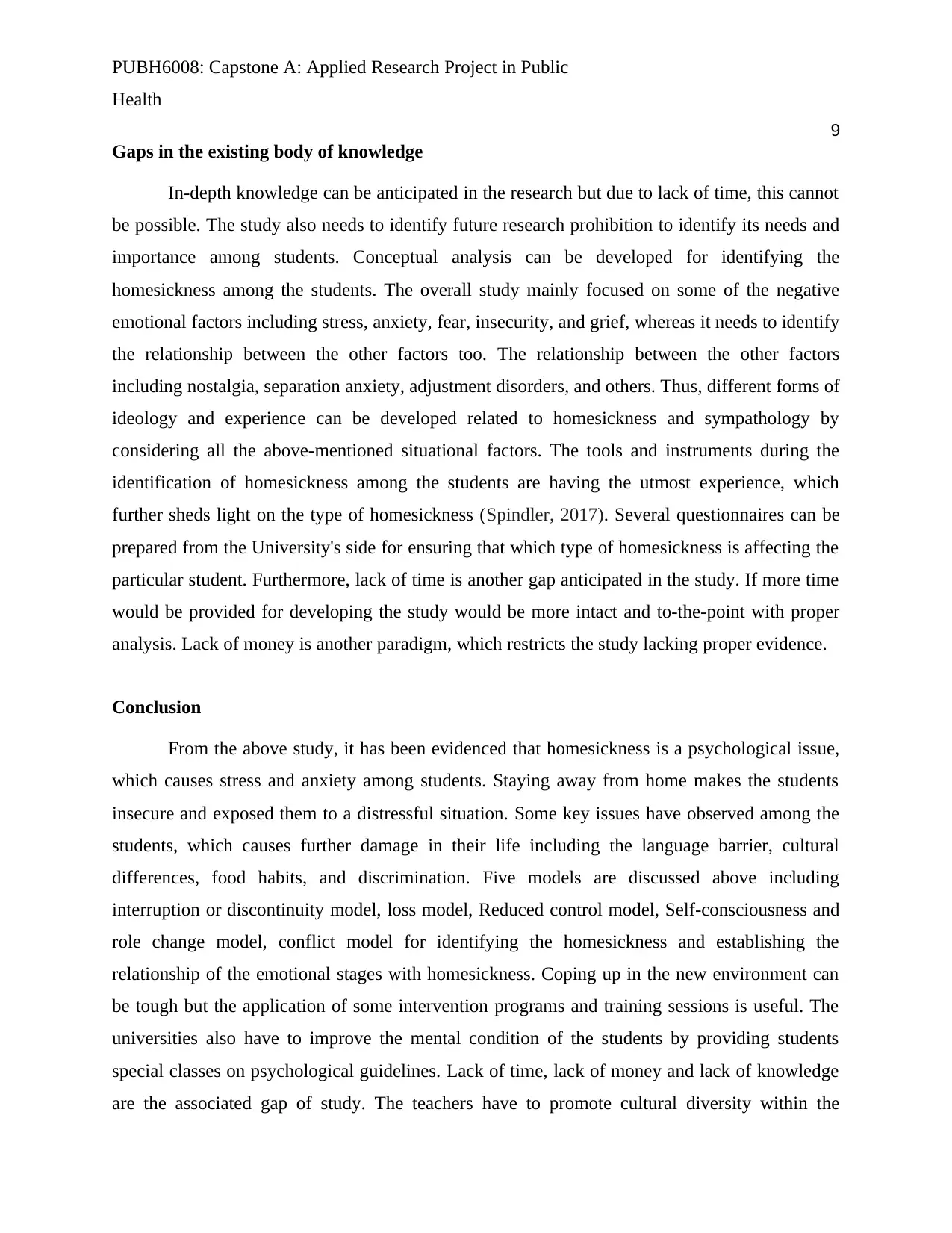
PUBH6008: Capstone A: Applied Research Project in Public
Health
9
Gaps in the existing body of knowledge
In-depth knowledge can be anticipated in the research but due to lack of time, this cannot
be possible. The study also needs to identify future research prohibition to identify its needs and
importance among students. Conceptual analysis can be developed for identifying the
homesickness among the students. The overall study mainly focused on some of the negative
emotional factors including stress, anxiety, fear, insecurity, and grief, whereas it needs to identify
the relationship between the other factors too. The relationship between the other factors
including nostalgia, separation anxiety, adjustment disorders, and others. Thus, different forms of
ideology and experience can be developed related to homesickness and sympathology by
considering all the above-mentioned situational factors. The tools and instruments during the
identification of homesickness among the students are having the utmost experience, which
further sheds light on the type of homesickness (Spindler, 2017). Several questionnaires can be
prepared from the University's side for ensuring that which type of homesickness is affecting the
particular student. Furthermore, lack of time is another gap anticipated in the study. If more time
would be provided for developing the study would be more intact and to-the-point with proper
analysis. Lack of money is another paradigm, which restricts the study lacking proper evidence.
Conclusion
From the above study, it has been evidenced that homesickness is a psychological issue,
which causes stress and anxiety among students. Staying away from home makes the students
insecure and exposed them to a distressful situation. Some key issues have observed among the
students, which causes further damage in their life including the language barrier, cultural
differences, food habits, and discrimination. Five models are discussed above including
interruption or discontinuity model, loss model, Reduced control model, Self-consciousness and
role change model, conflict model for identifying the homesickness and establishing the
relationship of the emotional stages with homesickness. Coping up in the new environment can
be tough but the application of some intervention programs and training sessions is useful. The
universities also have to improve the mental condition of the students by providing students
special classes on psychological guidelines. Lack of time, lack of money and lack of knowledge
are the associated gap of study. The teachers have to promote cultural diversity within the
Health
9
Gaps in the existing body of knowledge
In-depth knowledge can be anticipated in the research but due to lack of time, this cannot
be possible. The study also needs to identify future research prohibition to identify its needs and
importance among students. Conceptual analysis can be developed for identifying the
homesickness among the students. The overall study mainly focused on some of the negative
emotional factors including stress, anxiety, fear, insecurity, and grief, whereas it needs to identify
the relationship between the other factors too. The relationship between the other factors
including nostalgia, separation anxiety, adjustment disorders, and others. Thus, different forms of
ideology and experience can be developed related to homesickness and sympathology by
considering all the above-mentioned situational factors. The tools and instruments during the
identification of homesickness among the students are having the utmost experience, which
further sheds light on the type of homesickness (Spindler, 2017). Several questionnaires can be
prepared from the University's side for ensuring that which type of homesickness is affecting the
particular student. Furthermore, lack of time is another gap anticipated in the study. If more time
would be provided for developing the study would be more intact and to-the-point with proper
analysis. Lack of money is another paradigm, which restricts the study lacking proper evidence.
Conclusion
From the above study, it has been evidenced that homesickness is a psychological issue,
which causes stress and anxiety among students. Staying away from home makes the students
insecure and exposed them to a distressful situation. Some key issues have observed among the
students, which causes further damage in their life including the language barrier, cultural
differences, food habits, and discrimination. Five models are discussed above including
interruption or discontinuity model, loss model, Reduced control model, Self-consciousness and
role change model, conflict model for identifying the homesickness and establishing the
relationship of the emotional stages with homesickness. Coping up in the new environment can
be tough but the application of some intervention programs and training sessions is useful. The
universities also have to improve the mental condition of the students by providing students
special classes on psychological guidelines. Lack of time, lack of money and lack of knowledge
are the associated gap of study. The teachers have to promote cultural diversity within the
Paraphrase This Document
Need a fresh take? Get an instant paraphrase of this document with our AI Paraphraser

PUBH6008: Capstone A: Applied Research Project in Public
Health
10
campus so that students can learn how to respect each other’s culture, lifestyle, food habits, skin
tone, and other factors.
Health
10
campus so that students can learn how to respect each other’s culture, lifestyle, food habits, skin
tone, and other factors.
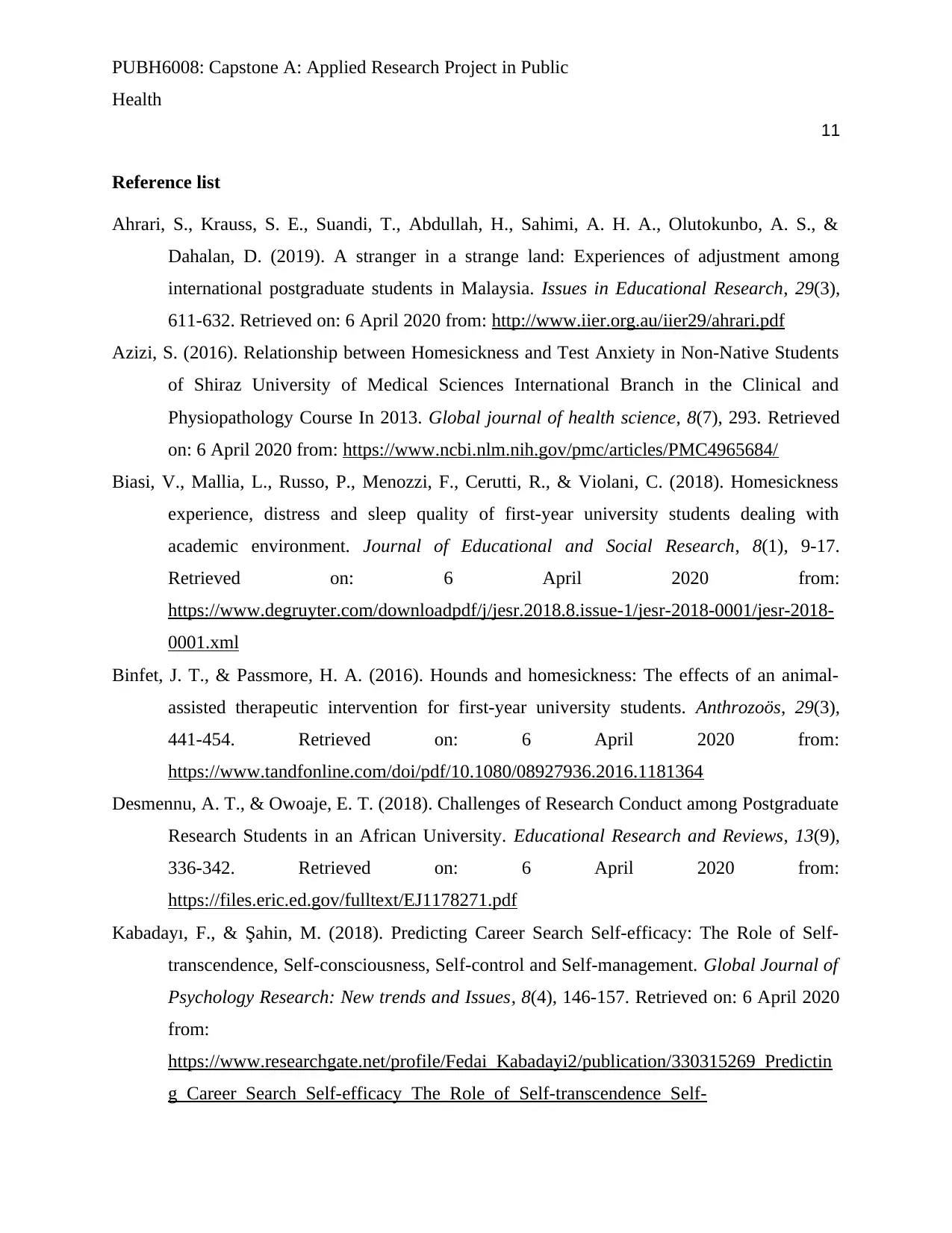
PUBH6008: Capstone A: Applied Research Project in Public
Health
11
Reference list
Ahrari, S., Krauss, S. E., Suandi, T., Abdullah, H., Sahimi, A. H. A., Olutokunbo, A. S., &
Dahalan, D. (2019). A stranger in a strange land: Experiences of adjustment among
international postgraduate students in Malaysia. Issues in Educational Research, 29(3),
611-632. Retrieved on: 6 April 2020 from: http://www.iier.org.au/iier29/ahrari.pdf
Azizi, S. (2016). Relationship between Homesickness and Test Anxiety in Non-Native Students
of Shiraz University of Medical Sciences International Branch in the Clinical and
Physiopathology Course In 2013. Global journal of health science, 8(7), 293. Retrieved
on: 6 April 2020 from: https://www.ncbi.nlm.nih.gov/pmc/articles/PMC4965684/
Biasi, V., Mallia, L., Russo, P., Menozzi, F., Cerutti, R., & Violani, C. (2018). Homesickness
experience, distress and sleep quality of first-year university students dealing with
academic environment. Journal of Educational and Social Research, 8(1), 9-17.
Retrieved on: 6 April 2020 from:
https://www.degruyter.com/downloadpdf/j/jesr.2018.8.issue-1/jesr-2018-0001/jesr-2018-
0001.xml
Binfet, J. T., & Passmore, H. A. (2016). Hounds and homesickness: The effects of an animal-
assisted therapeutic intervention for first-year university students. Anthrozoös, 29(3),
441-454. Retrieved on: 6 April 2020 from:
https://www.tandfonline.com/doi/pdf/10.1080/08927936.2016.1181364
Desmennu, A. T., & Owoaje, E. T. (2018). Challenges of Research Conduct among Postgraduate
Research Students in an African University. Educational Research and Reviews, 13(9),
336-342. Retrieved on: 6 April 2020 from:
https://files.eric.ed.gov/fulltext/EJ1178271.pdf
Kabadayı, F., & Şahin, M. (2018). Predicting Career Search Self-efficacy: The Role of Self-
transcendence, Self-consciousness, Self-control and Self-management. Global Journal of
Psychology Research: New trends and Issues, 8(4), 146-157. Retrieved on: 6 April 2020
from:
https://www.researchgate.net/profile/Fedai_Kabadayi2/publication/330315269_Predictin
g_Career_Search_Self-efficacy_The_Role_of_Self-transcendence_Self-
Health
11
Reference list
Ahrari, S., Krauss, S. E., Suandi, T., Abdullah, H., Sahimi, A. H. A., Olutokunbo, A. S., &
Dahalan, D. (2019). A stranger in a strange land: Experiences of adjustment among
international postgraduate students in Malaysia. Issues in Educational Research, 29(3),
611-632. Retrieved on: 6 April 2020 from: http://www.iier.org.au/iier29/ahrari.pdf
Azizi, S. (2016). Relationship between Homesickness and Test Anxiety in Non-Native Students
of Shiraz University of Medical Sciences International Branch in the Clinical and
Physiopathology Course In 2013. Global journal of health science, 8(7), 293. Retrieved
on: 6 April 2020 from: https://www.ncbi.nlm.nih.gov/pmc/articles/PMC4965684/
Biasi, V., Mallia, L., Russo, P., Menozzi, F., Cerutti, R., & Violani, C. (2018). Homesickness
experience, distress and sleep quality of first-year university students dealing with
academic environment. Journal of Educational and Social Research, 8(1), 9-17.
Retrieved on: 6 April 2020 from:
https://www.degruyter.com/downloadpdf/j/jesr.2018.8.issue-1/jesr-2018-0001/jesr-2018-
0001.xml
Binfet, J. T., & Passmore, H. A. (2016). Hounds and homesickness: The effects of an animal-
assisted therapeutic intervention for first-year university students. Anthrozoös, 29(3),
441-454. Retrieved on: 6 April 2020 from:
https://www.tandfonline.com/doi/pdf/10.1080/08927936.2016.1181364
Desmennu, A. T., & Owoaje, E. T. (2018). Challenges of Research Conduct among Postgraduate
Research Students in an African University. Educational Research and Reviews, 13(9),
336-342. Retrieved on: 6 April 2020 from:
https://files.eric.ed.gov/fulltext/EJ1178271.pdf
Kabadayı, F., & Şahin, M. (2018). Predicting Career Search Self-efficacy: The Role of Self-
transcendence, Self-consciousness, Self-control and Self-management. Global Journal of
Psychology Research: New trends and Issues, 8(4), 146-157. Retrieved on: 6 April 2020
from:
https://www.researchgate.net/profile/Fedai_Kabadayi2/publication/330315269_Predictin
g_Career_Search_Self-efficacy_The_Role_of_Self-transcendence_Self-
⊘ This is a preview!⊘
Do you want full access?
Subscribe today to unlock all pages.

Trusted by 1+ million students worldwide
1 out of 15
Related Documents
Your All-in-One AI-Powered Toolkit for Academic Success.
+13062052269
info@desklib.com
Available 24*7 on WhatsApp / Email
![[object Object]](/_next/static/media/star-bottom.7253800d.svg)
Unlock your academic potential
Copyright © 2020–2025 A2Z Services. All Rights Reserved. Developed and managed by ZUCOL.





